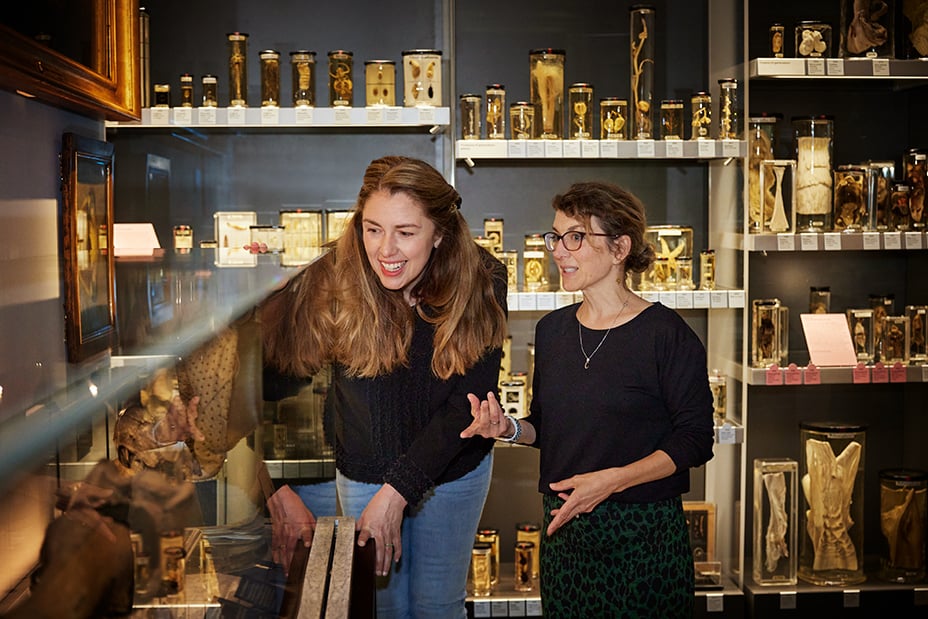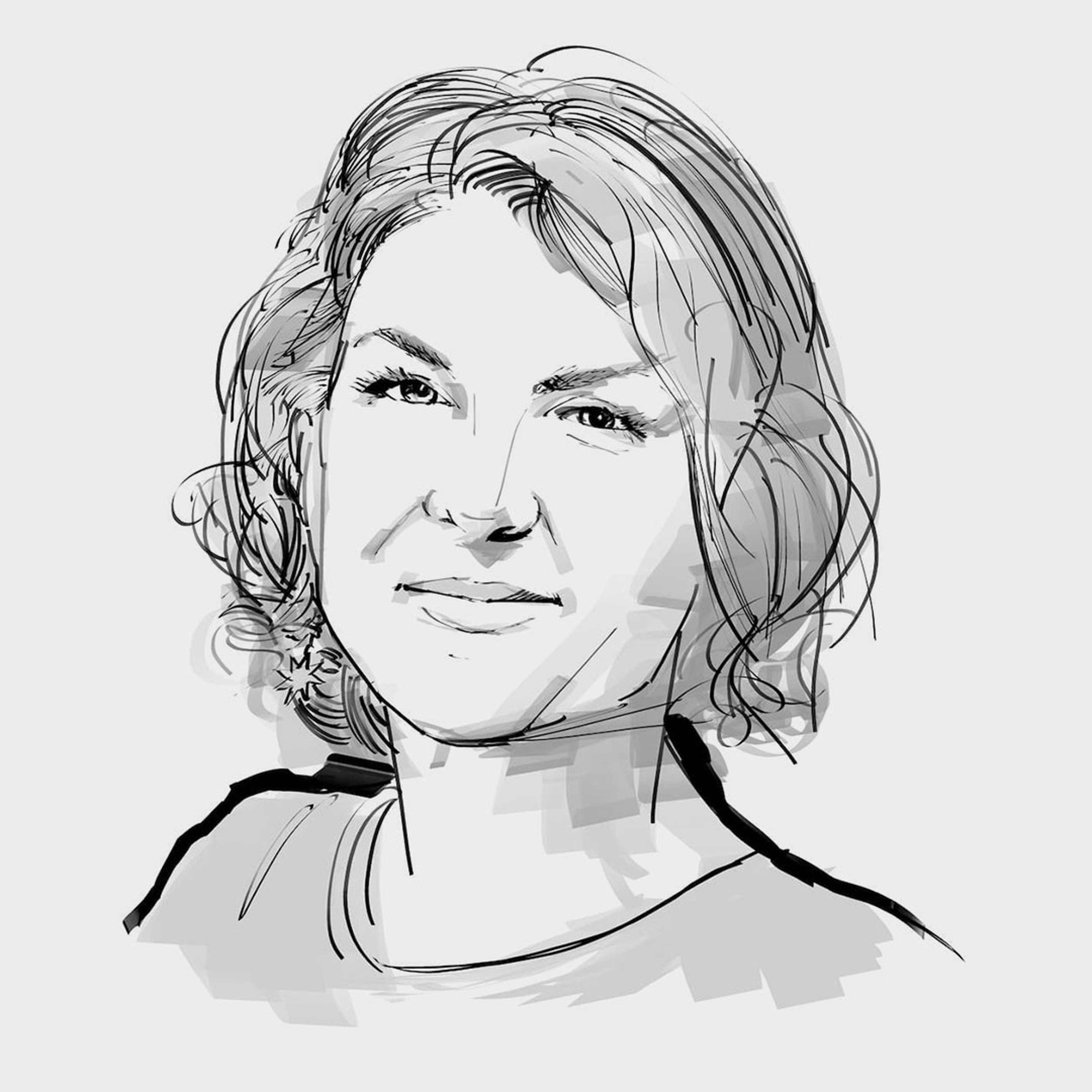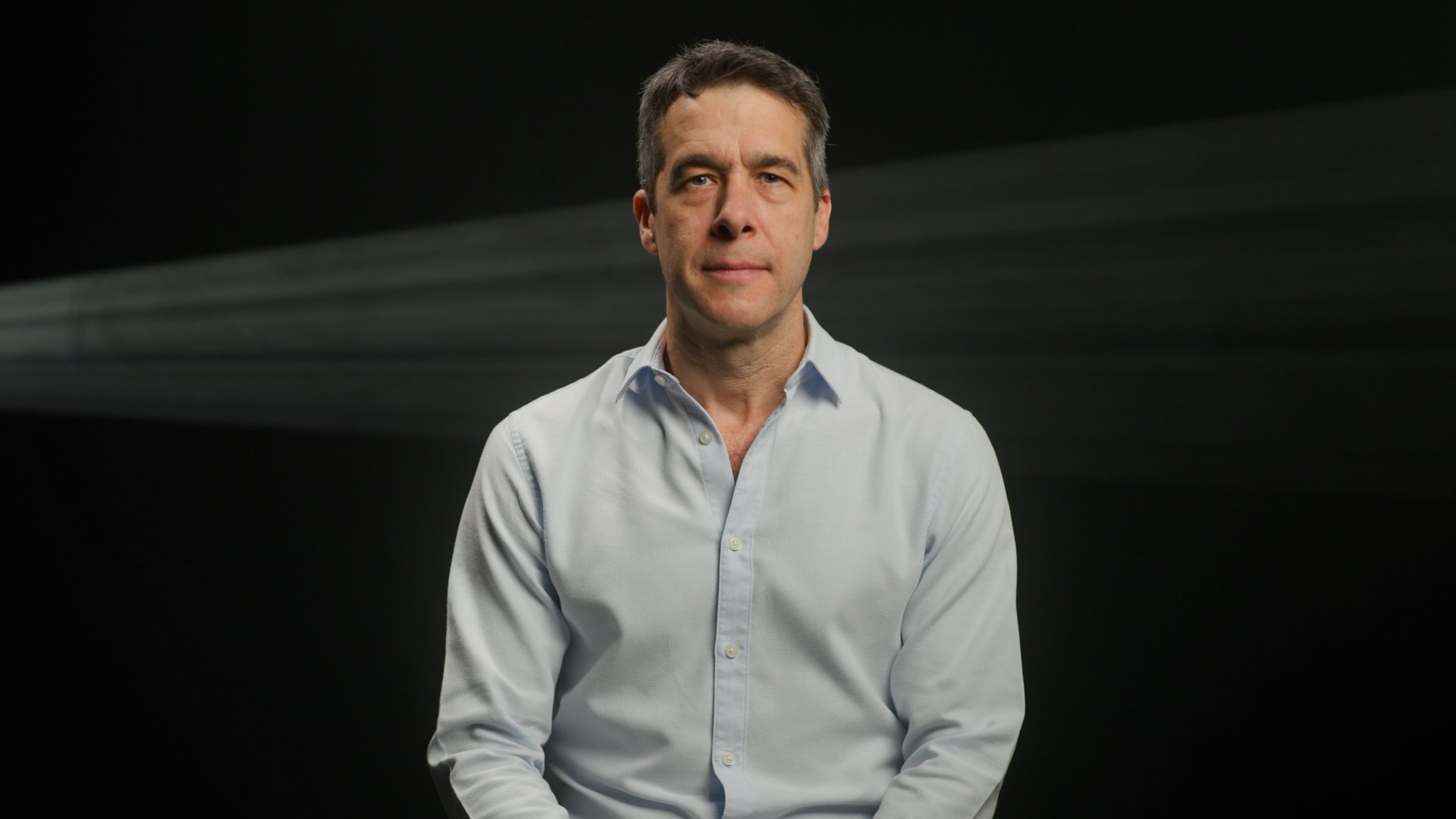
Sally Adee in the Hunterian Museum at the Royal College of Surgeons, London
Photography by David Vintiner.
Please remember that the value of an investment can fall and you may not get back the amount invested. This article originally featured in Baillie Gifford’s Autumn 2023 issue of Trust magazine.
In 2011, the US Army passed an electric current through Sally Adee’s head. She was writing at the time about how Pentagon scientists were experimenting with a brain enhancer called transcranial direct-current stimulation (tDCs) to improve soldiers’ reflexes.
As she recounts in her book, We Are Electric: The New Science of Our Body’s Electrome, she persuaded the researchers to let her try it out at a top-secret hangar in southern California.
She felt her focus sharpen when they turned on the power and nine volts coursed through her brain. As a swarm of computer-generated attackers descended from all sides, she confidently aimed her rifle and took them out one by one.
The current had transformed panic into cool concentration. “It felt incredible,” she says, but mostly it made her curious about how a jolt of electricity could affect a human brain. “I said: ‘People aren’t robots! How are you doing this?’”
Electricity’s in charge
The New Scientist writer had been inspired by the work of Tufts University biologist Mike Levin, a pioneering researcher into bioelectricity’s capacity to restore damaged tissues. Nature, he told her, is fundamentally electric.
Everything that has lived has done so because of the bioelectrical currents created by the movement of ions across cell membranes. They control what grows where and perhaps which gene gets expressed, every thought and feeling we have – even whether we live or die.
Bioelectricity is different from that which powers your lightbulbs. Rather than being based on a current of negatively charged particles, the human body runs on a flow of tiny, positively charged elemental particles such as potassium, sodium and calcium ions that carry signals from the brain to the rest of our body.
Harnessing this phenomenon could do much more than temporarily boost focus. If research efforts prevail, we could treat everything from cancer to paralysis and even grow new limbs from scratch.
A history of mystery
US-born Adee tells me this in London, her adopted home. We’re at the Hunterian Museum, a treasure trove of biological samples collected by the pioneering Scots surgeon John Hunter in the 1700s.
Looking at his specimens, we wonder how medicine might have been different if Hunter had known about bioelectricity.
In his day, sceptics such as physicist Alessandro Volta dismissed the role of electricity in the animal nervous system, while biologists found it difficult to understand its significance. A long battle between the two camps to claim electricity for their own discipline shaped how anatomists considered or disregarded it for years.
Italian anatomist Luigi Galvani discovered the first evidence that ‘animal electricity’ flowed through frogs’ bodies in 1786, but his findings only became widely known in the 19th century.
Even then, the reception was mixed. Galvani’s experiments inspired his nephew, Giovanni Aldini, to use electricity to animate human corpses in crowd-pleasing demonstrations, one of which gave Mary Shelley the idea for Frankenstein. But the showmanship did little for the reputation of bioelectricity as a serious topic.

Sally Adee and Caroline Williams
Lessons in science
Adee’s book traces the history of the idea up to the present day as it was repeatedly hailed as a breakthrough and then dismissed as pseudoscience, usually because somebody got carried away and tried to sell a product too soon.
Each time bioelectricity found its place in scientific research, hopes were dashed by a miracle cure that failed to live up to the hype, or there was a lack of the long-term investment needed to turn scientific theory into practical therapies.
Adee’s interest in the electrome dates from a childhood reading of James Tiptree’s sci-fi novella The Girl Who Was Plugged In. It tells the story of a disillusioned young woman who agrees to have her brain connected to a computer to control a lifeless body remotely.
The book prompted Adee to consider how technology could be wired into the human body, inspiring her to become a science journalist.
After a stint as a reporter at the New York-based technology magazine IEEE Spectrum, she moved to London to become an editor at New Scientist.
“I was such a tech-head at the beginning of my career,” she explains.
“The old me was like ‘put a chip in my head!’. Now I don’t recognise that person. I think brain implants are good as a treatment of last resort, but we still don’t understand so much about biology. It’s arrogant to think those implants are our future.”
Current investments
Baillie Gifford-managed investment trusts contain two healthcare firms using electricity to treat disease.
ShockWave Medical (held by Edinburgh Worldwide Investment Trust) uses a technology called lithotripsy, which was developed to break up kidney stones. It can treat conditions such as heart disease by sending electrical pulses to clear calcium blockages in blood vessels. Lithotripsy is safer than traditional methods that can tear soft tissue.
Novocure (held by Edinburgh Worldwide Investment Trust, The Monks Investment Trust and Baillie Gifford US Growth Trust) is improving the survival rates of brain cancer sufferers by attacking glioblastoma tumours with electric fields through its Optune headwear device.
Healing properties
Even with long-term goals, investors could be forgiven for being confused about which potential benefit of bioelectricity to focus on. So where would Adee put her money?
“Wound healing,” she says without hesitation. “If we could figure out how to coax cells to move toward each other or differentiate into a particular kind of tissue… you’d get a window into spinal regeneration and why cancer cells have strange electrical signalling.”
According to figures from 2018, there are 2.2 million people in the UK with chronic wounds, costing the NHS £5.3bn a year. Mastering wound healing would be a breakthrough indeed, and it’s not far out of reach.
Researchers from the California Institute of Technology have already developed a bioelectronic device that can stick to the skin. It monitors a wound’s temperature and pH, among other factors, which could help indicate whether it’s infected and encourage healing.
A spark of hope
With further understanding of the intricacies of bioelectricity, future scientists could do much better than sci-fi fantasies of upgrading our brains and bodies with silicon implants.
Adee agrees. “We’re not going to become cyborgs,” she says. “When you look at the electrical complexity of biology, you realise that whatever we’ve built so far doesn’t hold a candle to what we already have.”
Academics are waking up to this reality – this time with a more joined-up approach. At MIT’s Department of Biological Engineering, for example, students are specifically trained to think across disciplines in a way scientists of previous decades could only dream of.
While scientific study is advancing, it’s fair to say commercialisation on a large scale could take some time.
But research into our bodies’ complex electrical systems could spark a new surge of medical innovation – and with it, opportunities for entrepreneurs and investors.

The views expressed in this article should not be considered as advice or a recommendation to buy, sell or hold a particular investment. The article contains information and opinion on investments that does not constitute independent investment research, and is therefore not subject to the protections afforded to independent research.
Some of the views expressed are not necessarily those of Baillie Gifford. Investment markets and conditions can change rapidly, therefore the views expressed should not be taken as statements of fact nor should reliance be placed on them when making investment decisions.
Baillie Gifford & Co Limited is wholly owned by Baillie Gifford & Co. Both companies are authorised and regulated by the Financial Conduct Authority and are based at: Calton Square, 1 Greenside Row, Edinburgh EH1 3AN.
The investment trusts managed by Baillie Gifford & Co Limited are listed on the London Stock Exchange and are not authorised or regulated by the Financial Conduct Authority.
A Key Information Document is available by visiting bailliegifford.com
58427 10035675




